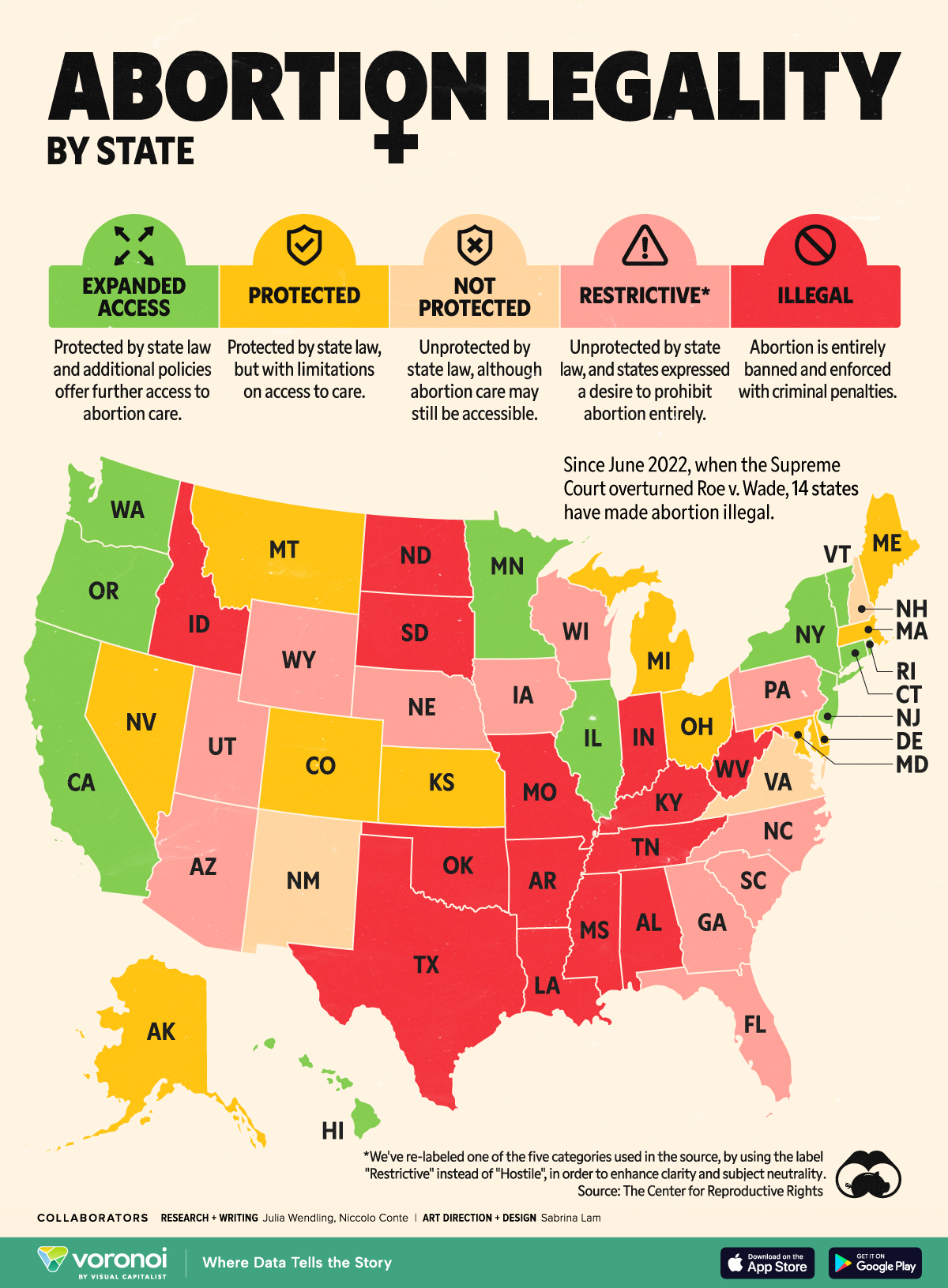Julia Wendling
2024-06-29 16:07:15
www.visualcapitalist.com
![]() See this visualization first on the Voronoi app.
See this visualization first on the Voronoi app.

Abortion Legality in America by State
This was originally posted on our Voronoi app. Download the app for free on iOS or Android and discover incredible data-driven charts from a variety of trusted sources.
In June 2022, the U.S. Supreme Court overturned Roe v. Wade, opening the door for states to make their own decisions regarding abortion legality.
In this graphic, we visualize how each U.S. state has altered abortion legality in the post-Roe era, using data from the Center for Reproductive Rights.
What Is Roe v. Wade?
Roe v. Wade refers to the landmark ruling by the Supreme Court in 1973 that dictated that the Constitution of the United States protected an individual’s right to have an abortion.
For over 50 years, the ruling prevented states from banning or significantly restricting abortion to their populations.
As of June 2022, this is no longer the case, as five Supreme Court justices voted to overturn Roe, while four supported maintaining it.
What Happened After Roe Was Overturned?
Since the June 2022 ruling, 14 states—including Texas, Missouri, and much of the South—have made abortion illegal.
| State | Abortion Legality Status |
|---|---|
| Alabama | Illegal |
| Alaska | Protected |
| Arizona | Restrictive |
| Arkansas | Illegal |
| California | Expanded Access |
| Colorado | Protected |
| Connecticut | Expanded Access |
| Delaware | Protected |
| Florida | Restrictive |
| Georgia | Restrictive |
| Hawaii | Expanded Access |
| Idaho | Illegal |
| Illinois | Expanded Access |
| Indiana | Illegal |
| Iowa | Restrictive |
| Kansas | Protected |
| Kentucky | Illegal |
| Louisiana | Illegal |
| Maine | Protected |
| Maryland | Protected |
| Massachusetts | Protected |
| Michigan | Protected |
| Minnesota | Expanded Access |
| Mississippi | Illegal |
| Missouri | Illegal |
| Montana | Protected |
| Nebraska | Restrictive |
| Nevada | Protected |
| New Hampshire | Not Protected |
| New Jersey | Expanded Access |
| New Mexico | Not Protected |
| New York | Expanded Access |
| North Carolina | Restrictive |
| North Dakota | Illegal |
| Ohio | Protected |
| Oklahoma | Illegal |
| Oregon | Expanded Access |
| Pennsylvania | Restrictive |
| Rhode Island | Expanded Access |
| South Carolina | Restrictive |
| South Dakota | Illegal |
| Tennessee | Illegal |
| Texas | Illegal |
| Utah | Restrictive |
| Vermont | Expanded Access |
| Virginia | Not Protected |
| Washington | Expanded Access |
| West Virginia | Illegal |
| Wisconsin | Restrictive |
| Wyoming | Restrictive |
Views on abortion in another 11 states are considered “restrictive,” meaning the states have indicated a desire to ban abortion and have no protections in place. Large variability, however, exists among these states. For example, Florida has restricted abortion after 6 weeks, except in cases where the woman’s life is at risk, whereas Arizona has restricted abortion after 15 weeks.
Conversely, 11 states—predominantly located on the East and West coasts—have moved to increase access to abortions and associated care in the wake of the decision to overturn Roe. Again, variability among this group exists. Oregon and New York have no restrictions based on gestation time. California and Hawaii restrict abortion access at fetal viability (24-26 weeks). Also, states in the “expanded access” category tend to have a higher concentration of abortion clinics, making care more readily accessible.
An additional 11 states have opted to protect abortions rights, though some gestational limitations may still exist. For instance, Kansas has restricted abortions after 22 weeks, but a statewide referendum in August 2022 upheld the right to abortion.
Abortion is accessible to varying degrees in the remaining states, but no specific protections are in place.
Abortion Legality Worldwide
While abortion is legal in many developed countries, it remains prohibited or highly restricted in several others, including the U.S., Poland, Malta, and Ireland.
The U.S. is also one of the few countries to have rolled back abortion laws in the last 30 years. The country is joined by Poland, Nicaragua, and El Salvador who have also tightened abortion legality.
In contrast, over the last three decades, over 60 countries have moved to expand abortion access. As a result, 60% of women who are of reproductive age—totaling 1.12 billion—live in regions where abortion is broadly legal.
See More Graphics about Healthcare
If you found this interesting, check out this visualization on life expectancy trends in the United States.
The post Mapped: Abortion Legality by U.S. State appeared first on Visual Capitalist.





































































